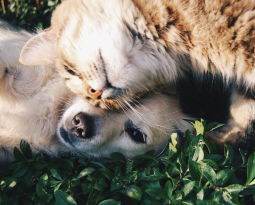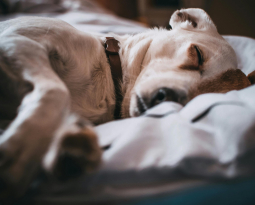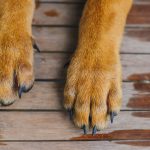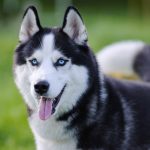At Acoma Animal Clinic, our goal is to keep your pet happy and healthy. Helping you treat a bald spot on your beloved dogs falls under that umbrella.
Keep reading, where we’ll look at:
- What a bald spot on a dog is
- Common causes for dog bald spots
- At Home Care and Veterinary Assistance
Dog Bald Spot Versus Shedding
A bald spot on a dog is just that: a patch of open skin where there used to be hair. While losing some hair here or there is a normal part of life, there is a difference between healthy shedding and losing the hair to any number of ailments.
At first sight, chunks of your dog’s hair on the floor or your couch might be alarming. Those of us with double-coated dogs might not bat an eye, but it’s a good idea to keep track of your dog’s shedding season. Whether they’re a seasonal offender, like the howling husky, or they shed time to time like any other dog, it’s a good idea to keep track of when your dog sheds their coat and how much hair is usually lost.
Anything unusual might be the first symptom before that patch on your dog thins into a bald spot. And while not all bald spots are cause for alarm, noting a change in their shedding habits could be the preventative care your beloved pooch needs.
Common Causes For Dog Bald Spots
Just like us humans, there are often dozens of explanations for one ailment. Let’s take a look at some of the most notable causes for bald spots in dogs.
Pressure Sores
A pressure sore occurs on any mammal when prolonged pressure in one area – particularly places where the bone is less guarded by muscle and fat – leads to a callus.
Take a look at where the bald spot is on your dog. Most notably with pressure sores, the bald patches are found on your dog’s elbows and any other bony part of your dog’s body.
Pressure sores typically occur in older and heavier dogs who lays in one position for extended periods of time. While it’s less likely to occur if your dog lays on a cushioned surface, prolonged pressure in one spot can lead to the loss of hair as the skin beneath begins to harden and form protection by way of a callus.
Genetic Alopecia
Alopecia is the loss of hair, whether permanent or temporary, and it plays a role in the dog world just like it does in the human world. We’ll continue to discuss other reasons for dog bald spots, but some breeds are genetically prone to losing their hair.
These breeds include: Bulldogs, Dobermans, Yorkshire Terriers, Dachshunds, and Greyhounds.
Coat Clipping As a Cause for Dog Bald Spots
Arctic Dog breeds, such as the Siberian Husky, have thick, double coats. These coats are not designed to be shaved, but as their popularity in warmer climates grow, we’re seeing more and more of thick dog coats being clipped. This can lead to a post-clipping alopecia (baldness) that is best treated by patiently waiting for their hair to regrow.
The ASPCA does not recommend shaving double-coated dogs even in warmer climates. To avoid bald spots due to clipping – and to avoid more serious consequences – please ask your vet prior to having your lusciously-coated dog shaved. While coat maintenance helps keep your dog healthy and happy, thick coats and double coats genetically help keep your dog cool as well as warm. Best practice to keep your dog cool is to provide plenty of shade, plenty of water, and to bring them indoors in excessively hot climates.
Allergies or Infections
Where there’s an allergy or irritant there is itching and scratching. Your dog is capable of having allergies to anything we humans do. From environmental factors such as grass and pollen to something they’ve eaten, if your dog’s skin itches, they’re going to scratch, bite, or lick it.
Excessive scratching, biting, and licking at irritated skin can lead to bald patches on your dog.
These reactions typically last a few days and can be treated by keeping your dog from constantly scratching at the afflicted sight. There are certainly natural remedies you can use to help reduce the itch, but it’s important to know your dog, avoid irritants, and consult your vet prior to giving at-home medication.
It is also important to note whether this is a topical allergy, or if your dog is having an allergic reaction. Contact your vet if you think your dog may be having a severe reaction. Symptoms may include: vomiting, lack of appetite, swelling, and hives.
Underlying Disease
Be alert, not anxious. Underlying disease is a foreboding phrase, but even if your dog is diagnosed by your vet with something underlying, they can still lead a happy life.
Two underlying diseases that may leave your dog afflicted with dog spots are Cushing’s Disease, and hypothyroidism.
Common Symptoms for Cushing’s Disease in dogs include:
- Extreme thirst and more frequent urination
- Hair loss – typically on the flanks, neck, perineum,
- Obesity
- Lethargy
Common Symptoms for Hypothyroidism in dogs include:
- Hair loss – typically on a dog’s trunk, hind legs, and tail
- Dull/flaky skin
- Weight gain
- Sluggish behavior
Those are only a few symptoms, and if you’re concerned your dog’s bald spots could be from something more serious, contact your vet and set up an appointment.
At Home Care and Veterinary Assistance
Dog Bald Spots: Caring for Your Dog’s Skin and Coat
If your dog’s bald spots are from pressure, your vet will likely recommend providing cushioned surfaces for your dog to rest. If your dog is anything like mine, they’ll lay down on the floor right next to that expensive dog bed.
Allergies can be treated at home for the most part. Your vet will have more specific recommendations for your dog, but in general, you can apply various topical salves along with your vet’s recommended allergy medication.
- Apple Cider Vinegar (never to an open wound or directly to your dog’s skin)
- Coconut Oil
- Vitamin E Oil
- Oatmeal and Chamomile Baths
Seeking Assistance
Before applying any remedy, check with your vet to ensure there are no underlying conditions that need to be treated. Home remedies are great options to keep your dog’s coat healthy, but they may need extra assistance from their vet.
If you’re in the Tucson area, Acoma Animal Clinic will be happy to set up an appointment to ensure your dog’s bald spots are treated with the best possible care and to bring you peace of mind.







